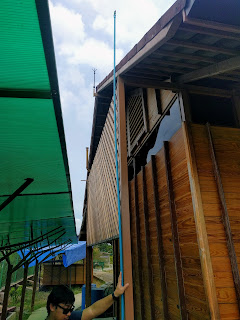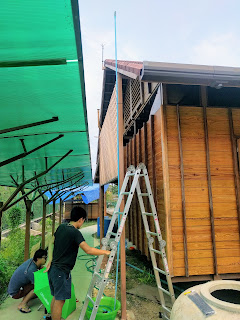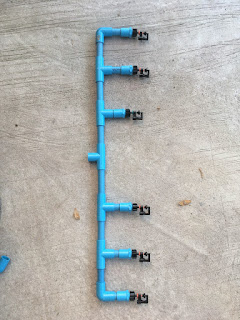Originally, I decided to go without insulation on the roof of BaanMae to reduce the chance of critters building nests between the insulation and the roof tiles. Our old house had rats in the attic, and all kinds of bugs and mold in the walls, and Praew has allergies that made her miserable much of the time.
Instead, I experimented with a clear polycarbonate roof inside and large slatted gable vents turning the attic into a kind of wind tunnel. The polycarbonate is clear so we can still see if there are any critters up there and easy to pop up and clean. And the wind tunnel action worked so well that many nights the wind has enough force to entirely lift up the 2.4m x 1.2m polycarbonate sheets and move them around. (We added velcro strips to hold them down.)
But BaanMae is still quite hot, and I am starting to reconsider whether we need to get some kind of insulation up there. My suspicion is that the wind tunnel pushes almost all of the hot air that heats up under the roof during the day out, mostly eliminating convection and conduction heat flows. But it doesn’t really do anything for radiated heat. So I am considering gluing on some of the the foil insulation that reflects back 90%+ of the radiation back upwards. Something like this.
But a simpler experimental solution I am going to try in the short term is to add sprinklers to the roof. This is often times used in canal-side restaurants around Thailand to cool down the place, so I figure it may be worth a shot here. We have plenty of collected rain water and filtered grey water, and the roof has gutters that would simply collect any run-off from the sprinklers and feed it back into the rain water collection system.
But I would like to use DC pumps so that we are using both collected water and collected electricity. (From the solar panels.) 😉
Here is a close-up of the sprinklers we are testing:
They were purchased at the local hardware store and cost about 20 THB each (less than $1).
We grabbed a small tub of water and dropped in two of the 24VDC 6m head 900L/h pumps I have for such experiments and we connected the two pumps in series using PVC pipe:
Putting the sprinkler on the end of the PVC pipe and connecting up two 12V sealed lead-acid batteries, we have a working sprinkler:
The flow rate is much less, but the spray radius is about 2.5m at the 5.3m height even with 6 in parallel. This seems like a perfect solution since I’m not particularly worried about flow rate since I want most of the water to evaporate rather than run down anyway.
So hopefully we can have these sprinklers up on the roof by the end of March when things really start to get hot during the day. (Well, it is already starting to get hot, but it will get even hotter.)







